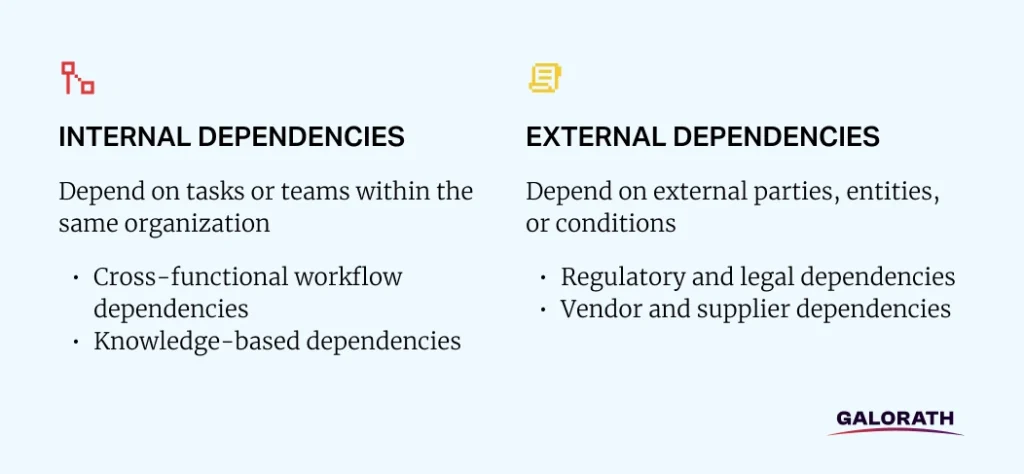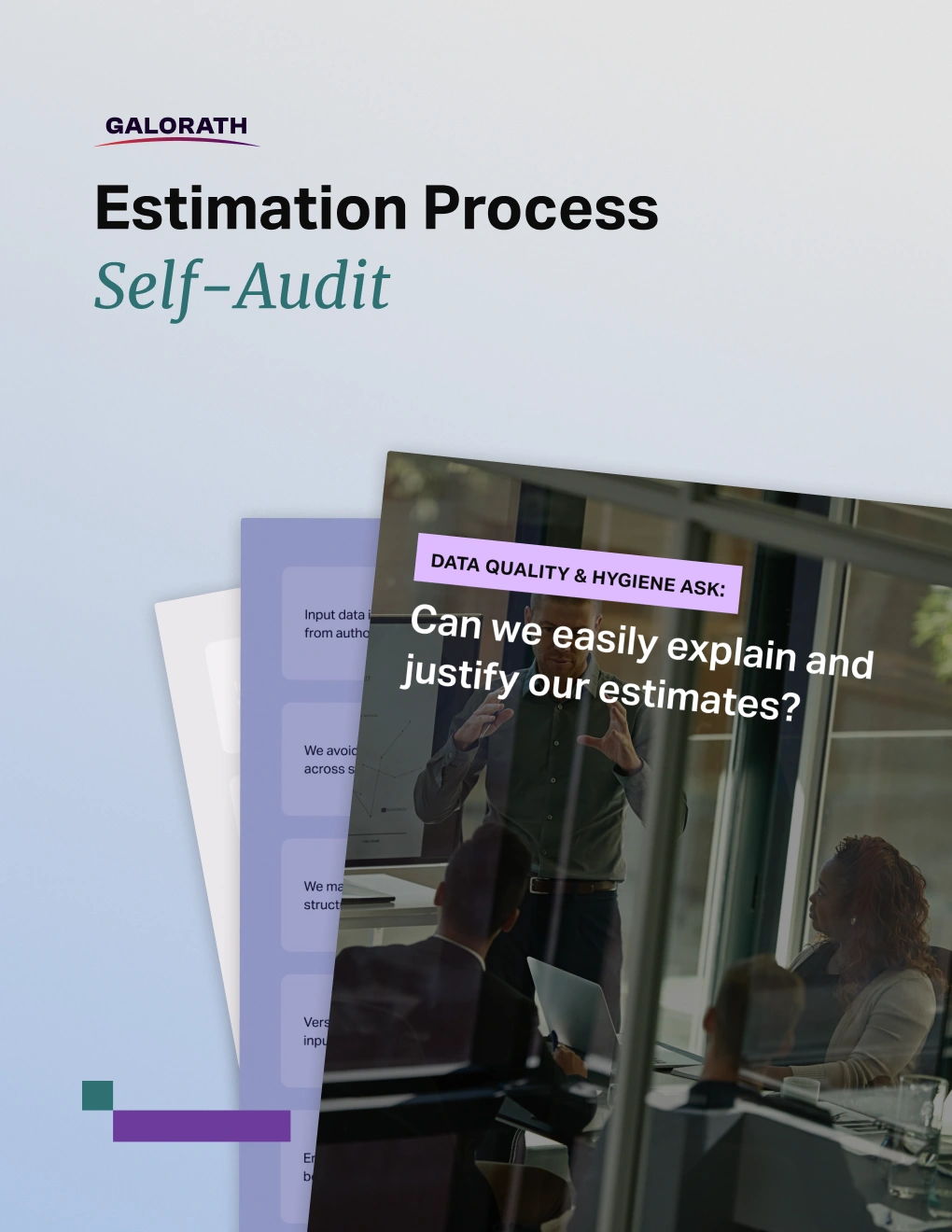Mastering Cost Risk with the CRED Model: A New Approach to Managing Uncertainty
Project dependencies are the relationships between tasks that define the order in which work must be completed. They are central to project planning, resource coordination, and risk management, ensuring that deliverables are aligned and delays are minimized. Whether managing a product launch or a cross-functional IT rollout, identifying and managing dependencies is key to staying on track.
Dependencies are typically categorized by their nature (logical, resource-based, preferential, internal, external, and cross-team). Each type has unique implications for scheduling and coordination. For example, regulatory approvals introduce external dependencies that must be factored into timelines, while resource constraints can create bottlenecks between otherwise independent tasks.
Timing-based dependencies further define how tasks relate. These include Finish-to-Start (FS), Start-to-Start (SS), Finish-to-Finish (FF), and Start-to-Finish (SF) relationships, each playing a role in how work is sequenced. Supporting terms such as lead time, lag, critical path, and mandatory dependencies help refine scheduling accuracy and prioritize tasks on the project’s timeline.
Dependency management focuses on identifying and monitoring these relationships to prevent misalignment. Tools such as Gantt charts, Kanban boards, dependency matrices, and Design Structure Matrices (DSM) make it easier to visualize complex interconnections and surface potential delays before they occur. These tools are especially useful in Agile and engineering environments, where work often overlaps across teams and timeframes.
Proper dependency management strengthens cross-team collaboration, improves predictability, and reduces risk. Yet challenges remain—from third-party disruptions to a lack of real-time visibility and unclear ownership. Addressing these issues starts with early identification, clear documentation, and continuous communication across all stakeholders.
Understanding the types, timing, tools, and techniques associated with dependencies helps project managers create more resilient schedules, reduce surprises, and deliver work more reliably, no matter the industry or complexity.
What are project dependencies?
Project dependencies are the logical relationships between tasks, activities, or milestones that dictate when and how they should be performed. Dependencies ensure that tasks are completed in the correct order and help project managers plan workflows, allocate resources, and prevent bottlenecks.
The A Guide to the Project Management Body of Knowledge (PMBOK Guide) does not directly define the term “dependency,” but instead refers to it through the concept of a logical relationship. According to the Guide, a logical relationship is “a dependency between two activities, or between an activity and a milestone”.
Dependencies are crucial because most tasks cannot be completed in isolation. One activity may rely on the completion or initiation of another. For example, you cannot start painting a wall until the plastering is finished. These relationships affect scheduling, resource planning, and risk management.
Dependencies also serve as the foundation for creating Gantt charts and network diagrams, which visually map out the sequence of activities. Project managers use these tools to detect potential scheduling conflicts and to adjust timelines before issues arise.
What is dependency management?
Dependency management is the process of identifying, analyzing, and controlling the relationships between tasks to ensure they occur in the correct sequence and do not cause project delays. Dependency management helps teams coordinate timelines, allocate resources effectively, and reduce the risk of bottlenecks or scheduling conflicts.
In project management, dependencies describe the required order of operations between tasks. For example, a software deployment cannot proceed until testing is complete. Managing these dependencies involves more than tracking them – it requires ongoing oversight, scenario planning, and clear communication to keep the project moving. Teams that manage dependencies well are more likely to stay on schedule and within scope.
According to the Project Management Institute’s Pulse of the Profession® 2023 report, organizations that invest in project management capabilities such as dependency tracking and schedule control are 2.5 times more likely to complete projects that meet original goals and business intent (PMI, 2023). This highlights the value of dependency management as a strategic practice that improves project outcomes and minimizes disruption.

Dependency management is especially important in Agile and hybrid delivery models. In dynamic environments where priorities shift quickly, tracking dependencies in real time allows teams to make changes without creating cascading delays. Tools like dependency matrices, Gantt charts, and Kanban boards help visualize task relationships and surface issues before they become blockers.
Without effective dependency management, even well-planned projects can fall behind. Missed dependencies can result in idle teams, duplicated work, and increased risk. By managing these relationships proactively, project managers gain more control, reduce uncertainty, and improve collaboration across teams.
Types of dependencies based on their nature
Types of dependencies based on their nature refer to the different ways tasks are connected, depending on what causes the dependency. Understanding the nature of each dependency helps project managers identify bottlenecks, anticipate risks, and optimize task sequencing.
There are 4 types of project dependencies based on their nature:
- Logical dependencies
- Resource dependencies
- Preferential dependencies
- Cross-team dependencies
Each type plays a unique role in shaping how tasks interact and how teams plan their schedules. Identifying the correct type of dependency helps ensure the project runs smoothly and meets its objectives.
Logical dependencies
Logical dependencies are dependencies that are required by the nature of the work itself. These are also known as mandatory dependencies and cannot be changed without fundamentally altering the project.
For example, in software development, the code must be written before it can be tested. These relationships are often mapped using tools like dependency diagrams or Gantt charts to reflect the correct sequencing of tasks.
Project managers use logical dependencies to build the project’s critical path. Failing to respect these dependencies often results in project delays or quality issues. Logical dependencies form the backbone of most project schedules.
Resource dependencies
Resource dependencies occur when two or more tasks share the same limited resource, such as a person, piece of equipment, or budget allocation. These dependencies are not based on the sequence of tasks, but on the availability of shared resources.
For instance, if two design tasks require the same graphic designer, they cannot be completed simultaneously unless more resources are added. This type of dependency is common in small teams or projects with tight resource constraints.
Resource dependencies can lead to bottlenecks if not managed proactively. Project managers use resource leveling techniques or scheduling software to allocate resources efficiently and avoid delays.
Preferential dependencies
Preferential dependencies are task relationships that are not required but are established based on best practices, team preferences, or efficiency considerations. These are also called discretionary dependencies.
An example of a preferential dependency might be performing code reviews after each sprint, even though technically, testing could begin without them. These choices often reflect internal processes or past experience rather than technical requirements.
Preferential dependencies can improve team workflow, communication, and quality. However, because they are flexible, they can be adjusted when time or resources are limited. Understanding which dependencies are preferential allows managers to make trade-offs without sacrificing project integrity.
Cross-team dependencies
Cross-team dependencies are dependencies that occur when one team’s task relies on another team’s output. These are especially common in large projects or organizations with matrix or Agile structures.
For instance, a frontend development team may depend on the backend team to finish APIs before they can implement the user interface. These interdependencies require strong coordination to avoid misalignment and delays.
Managing cross-team dependencies involves clear documentation, shared timelines, and regular check-ins. Tools like shared dashboards and communication protocols help ensure alignment across teams that may have different goals or working styles.
Internal dependencies
Internal dependencies are task relationships that occur within the same project team or organization and are fully under the project manager’s control. These dependencies connect tasks that rely on each other for sequencing, resource allocation, or knowledge sharing within the project’s boundaries.
For example, an internal dependency might involve a content writer who must complete an article draft before an editor can begin reviewing it. These dependencies are often found between departments, team members, or workflows that operate in the same organization. Internal dependencies are often easier to manage than external ones because they involve people and resources that are part of the same project structure.
Understanding internal dependencies is essential for optimizing project timelines. Project managers often track internal dependencies using task management software, Gantt charts, or dependency matrices to visualize how delays in one area could impact others.
Internal dependencies become especially important in Agile or cross-functional environments where multiple teams may be working in parallel. Mismanaging these relationships can lead to rework, communication breakdowns, and missed milestones. To reduce these risks, high-performing teams implement clear ownership, documentation, and regular syncs between dependent roles.
Below are examples of how internal dependencies appear in different functional settings:
Cross-functional workflow dependencies
Cross-functional workflow dependencies arise when teams within the same organization rely on one another to complete related tasks. For example, a design team may need to complete wireframes before the development team can begin coding. Although they operate under the same project umbrella, these teams must coordinate closely to avoid idle time and miscommunication.
Internal dependencies like this are often managed using collaborative project boards, shared milestones, and synchronized planning cycles to keep everyone aligned.
Knowledge-based dependencies
Knowledge-based dependencies occur when one team or role cannot proceed until they receive insights, documentation, or validation from another group. For example, a QA tester might need the product requirements documentation before writing test cases, or a compliance lead may need finalized system architecture to review for risk.
These dependencies require strong documentation practices and knowledge transfer processes to ensure progress is not delayed by information gaps. Teams that anticipate these needs early can reduce rework and avoid schedule slips.
This image compares and explains internal and external project dependencies.

External dependencies
External dependencies are task relationships that rely on individuals, teams, or organizations outside the immediate project team. External dependencies influence project outcomes but are not fully under the control of the project manager or internal stakeholders.
External dependencies often involve third-party vendors, government agencies, clients, or supply chain partners. Because these dependencies fall outside the organization’s direct oversight, they are more difficult to predict and control. They can lead to delays or cost increases if not managed carefully.
A common example of an external dependency is waiting for a regulatory agency to approve documentation before moving forward with implementation. Another might include a shipment of materials from a supplier that must arrive before production can begin. These dependencies introduce variables that require risk mitigation strategies, regular status checks, and clear communication between all involved parties.
Effective project managers handle external dependencies by building buffer time into the schedule, negotiating realistic deadlines with external stakeholders, and setting up transparent tracking systems. These efforts help reduce the impact of unforeseen delays and support proactive contingency planning.
Here are 2 common types of external dependencies seen in project environments:
Regulatory and legal dependencies
Regulatory and legal dependencies occur when a project is subject to government policies, permits, or industry regulations that must be satisfied before a task can proceed. These types of dependencies are especially common in construction, healthcare, finance, and energy sectors.
For example, in pharmaceuticals, trials cannot begin until approvals are granted by oversight bodies such as the FDA. These dependencies are essential for compliance but often introduce long and unpredictable waiting periods.
According to a 2023 McKinsey report on infrastructure delays, regulatory bottlenecks are responsible for up to 20% of project delays in the public sector. To manage these types of dependencies, project leaders should engage regulatory bodies early, maintain detailed records, and stay informed of changing laws.
Vendor and supplier dependencies
Vendor and supplier dependencies arise when a task is contingent on the delivery or performance of an external provider. These dependencies are common in manufacturing, logistics, and large IT implementations.
An example of a vendor dependency is when a product launch is delayed because a third-party software vendor has not completed a necessary integration. Another scenario could involve a delay in receiving raw materials from an overseas supplier, which puts the entire production schedule at risk.
To reduce the risks associated with vendor and supplier dependencies, many organizations include service-level agreements (SLAs) in their contracts. These agreements set expectations around timelines, delivery quality, and penalties for delays. Project teams also use tools like procurement trackers and vendor dashboards to monitor the status of outstanding tasks and deliveries.
Types of task dependencies based on timing
Types of task dependencies based on timing define how tasks are scheduled in relation to one another and when they can start or finish. These dependencies are essential for structuring a realistic project timeline and ensuring that work happens in the correct sequence.
Task dependencies describe the logical and temporal relationships between two or more tasks within a project. Understanding these relationships helps project managers plan schedules, allocate resources, and anticipate delays.
The 4 most common timing-based dependencies are:
- Finish to Start (FS)
- Finish to Finish (FF)
- Start to Start (SS)
- Start to Finish (SF)
Each type of dependency has a specific effect on how tasks interact and how the project progresses. Below is a breakdown of each dependency type with real-world context and examples.
Finish to Start (FS)
Finish to Start (FS) is the most common type of task dependency, where one task must finish before the next one can begin. This dependency enforces a clear sequence between tasks that cannot overlap.
An example of Finish to Start is in a publishing workflow. The content writing task must be completed before the editing process can begin. In construction, the foundation must be poured and cured before framing can start. These are sequential activities that depend on the completion of the first before initiating the second.
Finish to Start dependencies help project managers identify the critical path and prevent teams from starting work prematurely. Tools like Gantt charts are often used to visualize these dependencies and flag potential bottlenecks.
Finish to Finish (FF)
Finish to Finish (FF) is a dependency where two tasks must both be completed around the same time, but they do not necessarily need to start together. The second task cannot finish until the first one has also finished.
A practical example is found in event planning. The preparation of the venue and the setup of the stage both need to finish before the event can begin. These tasks may run in parallel, but they must both be completed for the event to proceed.
Finish to Finish dependencies help synchronize final deliverables, especially when multiple tasks are part of a larger milestone. Project managers often use this model to avoid gaps between related activities that must conclude at the same time.
Start to Start (SS)
Start to Start (SS) means two tasks must begin at the same time, even if they finish at different times. This dependency allows for parallel progress while still maintaining a coordinated launch.
For example, in software development, writing code and developing automated tests can begin at the same time. Although these tasks will have different durations, starting them together ensures collaboration and faster feedback loops.
Start to Start dependencies are useful in Agile and fast-paced environments. They help optimize schedules and reduce idle time by enabling simultaneous task execution.
Start to Finish (SF)
Start to Finish (SF) is the least common dependency type, where one task cannot finish until another task has started. This may seem counterintuitive but is useful in specific scheduling scenarios.
An example of Start to Finish is in shift scheduling. The outgoing employee cannot leave until the incoming employee has arrived and started their shift. The end of the first task is dependent on the beginning of the second.
Start to Finish dependencies are helpful when managing transitional activities, handovers, or continuous service coverage. While rare, they play a critical role in projects that involve resource rotation or high-stakes continuity.
The following visual outlines the four most common timing-based dependencies—finish-to-start, start-to-start, finish-to-finish, and start-to-finish—and how they affect task scheduling and project flow.

Important terms related to the dependencies
Some important terms related to the dependencies can help project managers better understand the timing, structure, and influence of task relationships within and across projects. Mastering these concepts improves scheduling accuracy, reduces delays, and increases the likelihood of successful project delivery.
Lead
Lead refers to the amount of time that a successor task can be advanced before its predecessor task is fully completed. Lead time enables overlapping tasks and is often used to speed up project delivery.
For example, in a marketing campaign, a design team may start creating ad banners before final content is written, allowing both tasks to progress simultaneously. This use of lead time is a common scheduling strategy to shorten overall duration without compromising task quality.
According to the Project Management Institute, lead is typically applied in Finish-to-Start relationships when early initiation of a task will not disrupt the predecessor’s completion (PMI PMBOK Guide, 6th ed.). Project managers use lead carefully to maintain alignment and avoid rework due to incomplete inputs.
Lag
Lag refers to the amount of delay imposed between two dependent tasks. Lag time forces a waiting period between the end of one task and the start of the next, even when the dependency would normally allow an immediate start.
For example, after pouring concrete in a construction project, there is often a lag of several days to allow curing before framing begins. This intentional pause ensures that the next task does not start too early and compromise the quality or safety of the work.
Lag can be built into project schedules to account for inspection approvals, delivery wait times, or other unavoidable gaps. Properly managing lag helps avoid idle time and allows more accurate forecasting of the overall timeline.
Critical path
Critical path refers to the sequence of tasks that determines the shortest possible duration for a project. Any delay in a critical path task will directly impact the project completion date.
The concept of critical path was introduced in the 1950s and remains one of the most widely used tools in project scheduling. Tasks on the critical path have zero slack or float, meaning they cannot be delayed without affecting the final deadline. These tasks receive the highest priority for monitoring and resource allocation.
Project managers use tools like Critical Path Method (CPM) charts to identify and manage these high-impact tasks. According to a 2023 report by Wrike, teams that actively monitor their critical path are 42% more likely to deliver projects on time.
Mandatory dependency
Mandatory dependency is a type of relationship between tasks that is legally or physically required. These dependencies are not flexible and cannot be changed without altering the project scope or violating regulatory or technical requirements.
For example, in road construction, paving cannot begin until excavation is complete. In software development, coding must be completed before testing can occur. These are known as hard logic constraints because they are dictated by the nature of the work.
According to PM Majik, mandatory dependencies are critical to recognize early in project planning. Failing to account for them can lead to unrealistic schedules, non-compliance, and costly rework.
Project interdependencies
Project interdependencies refer to the relationships between different tasks, resources, or outcomes within the same project. These connections require careful coordination because a change in one part of the project can affect another.
For instance, a delay in the design phase can push back the development and testing phases, even if those teams are ready to begin. These internal links between deliverables are common in large, multi-phase projects and must be documented and tracked.
As Project Management Academy explains, understanding interdependencies enables project leaders to anticipate cascading effects and allocate resources more effectively. Managing these connections requires visibility into the entire project workflow and close collaboration across functions.
Cross-project dependency
Cross-project dependency describes a relationship where a task in one project depends on the outcome or timing of a task in another, separate project. These dependencies are common in portfolio or program management, where multiple initiatives run concurrently.
For example, a company launching a new product may rely on another project team to complete software integration or regulatory certification. If the supporting project experiences delays, the dependent project cannot move forward.
Managing cross-project dependencies requires strategic oversight and clear communication between project managers. Organizations often use program-level planning tools to align goals, schedules, and resources across interconnected projects.
Design Structure Matrix
Design Structure Matrix is a visual tool used in project management to map and analyze dependencies between components, teams, or tasks in complex systems. Often referred to as dependency mapping, the Design Structure Matrix (DSM) helps identify relationships that may not be obvious during traditional planning and enables project managers to optimize task sequencing, communication flows, and execution strategies.
The DSM method was originally developed in the 1980s by Don Steward at MIT to represent system elements and their interactions in a square matrix format. Each row and column represents a task or component, and the cells indicate the presence or absence of a dependency between them. This matrix format allows project leaders to quickly identify circular dependencies, parallel opportunities, and critical paths.
Dependency mapping through a Design Structure Matrix is particularly relevant in engineering, software development, and product design, where tasks often involve feedback loops and interdependent processes. In these environments, linear planning tools such as Gantt charts may not capture the full complexity of overlapping or bidirectional relationships.
In Agile environments, DSMs are used to support team-level coordination and program-level visibility. According to Planview, visualizing dependencies between Agile teams improves collaboration and helps program managers proactively remove obstacles that would otherwise slow delivery. When teams rely on shared components or must deliver features in sync, mapping those dependencies supports incremental delivery and reduces rework.
One of the most valuable features of the Design Structure Matrix is its ability to highlight recursions or cycles. These represent dependencies that loop back to earlier stages of the project, which can create risk if not managed. By spotting these feedback loops early, teams can restructure work to avoid delays or integrate checkpoints for coordination.
Project managers use DSMs not just for documentation, but as part of a broader strategy to improve predictability and reduce complexity. Whether implemented manually or through software tools, Design Structure Matrices can scale from small product teams to enterprise portfolios.
Benefits of managing project dependencies
Benefits of managing project dependencies include improved scheduling, better team coordination, reduced risk, and greater control over project outcomes. Effective dependency management allows project teams to anticipate potential blockers, allocate resources strategically, and keep complex workflows on track.
One of the primary advantages is improved timeline accuracy. When dependencies are mapped and tracked, project managers can create more realistic schedules and avoid missed milestones. Identifying dependencies upfront enables teams to prepare for risks and build buffers where necessary, improving delivery predictability.
Another key benefit is enhanced collaboration. Dependencies often involve multiple team members or departments, and managing them clearly helps align efforts. Visualizing dependencies helps teams understand how their work affects others and promotes transparency across cross-functional initiatives.
Setting clear task dependencies reduces confusion and limits the number of status updates and handoffs required between teams. This leads to fewer delays, better handover quality, and less wasted time. In environments like Agile, where teams work in sprints, dependency tracking helps prevent bottlenecks and supports a steady delivery cadence.
Dependency management also helps reduce project risk. When critical tasks depend on external vendors, regulatory approval, or other uncontrollable variables, these risks can be monitored and mitigated more effectively if the dependencies are clearly outlined in advance. Proactively managing these risks improves resilience and helps avoid unplanned workarounds or last-minute scope changes.
Microsoft, in its 365 Life Hacks, emphasizes that managing project dependencies is essential for resolving bottlenecks early, noting that “dependencies that are not identified or managed correctly can stall the entire project”. This makes dependency management a strategic enabler, not just a tactical tool.
Ultimately, teams that actively manage project dependencies experience higher efficiency and better outcomes. They spend less time reacting to blockers and more time delivering value. Whether using Gantt charts, Kanban boards, or Design Structure Matrices, the key is to maintain visibility and foster communication across all connected tasks and teams.
Challenges of project dependency
Challenges of project dependency arise when task relationships are poorly defined, not tracked consistently, or involve external variables beyond the team’s control. These challenges can disrupt project flow, delay deliverables, and increase the likelihood of miscommunication and rework.
One of the most common problems is lack of visibility into dependent tasks. If teams do not clearly understand which tasks are linked and what sequence must be followed, it becomes difficult to track progress or identify blockers. Dependency-related delays often occur because stakeholders are unaware of the full impact a delayed task has on downstream activities.
Another challenge is unmanaged external dependencies. When a project relies on a third-party vendor, regulatory agency, or partner, any change in their schedule can create a cascading effect that stalls the internal project. Because these entities fall outside the project manager’s direct control, delays or changes can be difficult to forecast or mitigate. This makes external dependencies particularly high-risk and in need of active monitoring.
Overlapping responsibilities and poor coordination also contribute to dependency issues. In complex projects, especially those involving cross-functional teams, dependencies often span across departments. Without strong communication and ownership structures in place, tasks may be delayed because each team assumes the other is taking the lead.
Another critical challenge is task bottlenecks. When too many tasks are dependent on a single predecessor, any delay in that key task can put the entire timeline at risk. This is especially problematic when the resource responsible for the predecessor is overbooked or unavailable. Bottlenecks can compound if not detected early in the planning phase.
Finally, lack of dynamic tools or updated systems can make it difficult to adjust to changes in real time. Static project plans may not account for new dependencies that emerge during execution. Without real-time updates or alerts, project managers may discover conflicts too late to take effective action.
To overcome these challenges, organizations must invest in project management platforms that provide dependency visualization and real-time updates. Equally important is establishing a culture of transparency, where teams regularly communicate about task progress, blockers, and changes in scope or availability.
Project dependency examples
Project dependency examples help illustrate how task relationships operate in real-world scenarios across different industries and project types. These examples provide practical context that helps project managers identify, manage, and communicate dependencies more effectively.
Dependencies can arise due to timing, resources, technical requirements, or external obligations. Understanding how these dependencies play out across industries can help project leaders build more realistic timelines and reduce risk.
Project dependency examples by type and industry
Project dependency examples by type and industry demonstrate how task relationships vary based on project scope, industry needs, and resource availability. By examining these examples, teams can better align their planning efforts and avoid common scheduling conflicts.
Finish-to-Start (FS) Example — Marketing:
A content marketing campaign may require that a blog post be written and approved before it can be published or promoted on social media. The social media team cannot begin distribution until the content creation task is complete.
Start-to-Start (SS) Example — Software Development:
In Agile software development, developers may begin writing code at the same time that testers begin creating test cases. Both tasks start together to enable faster feedback loops, but they may finish at different times.
Finish-to-Finish (FF) Example — Event Planning:
When planning a corporate event, catering and venue setup need to finish at the same time. Although the setup might begin earlier, both tasks must end simultaneously for the event to begin smoothly.
Start-to-Finish (SF) Example — IT Services:
In IT support, a new shift of employees must start before the previous shift can leave. This is a common Start-to-Finish dependency, where the end of one task depends on the start of another to maintain service continuity.
Cross-functional Example — Product Development:
Dependencies often occur between departments. In product development, the marketing team may rely on the product team to finalize features before they can write messaging and campaign materials. This creates a cross-functional Finish-to-Start dependency between teams working in parallel.
External Dependency Example — Logistics:
A manufacturing project might depend on the delivery of raw materials from a third-party vendor. If the shipment is delayed, the production line cannot begin. This external dependency requires regular communication with suppliers and contingency planning.
Regulatory Dependency Example — Healthcare:
In pharmaceutical development, clinical trials cannot begin until approvals are received from regulatory bodies such as the FDA. These are mandatory, external dependencies that add lead time to the project schedule.
How to identify project dependencies?
How to identify project dependencies begins with understanding the sequence, relationships, and resource connections between tasks within a project. Recognizing these dependencies early allows project managers to map out workflows, allocate resources efficiently, and reduce the risk of delays.
The first step is to review the project scope and task breakdown. Identifying dependencies starts with breaking the project into smaller tasks using a Work Breakdown Structure (WBS). Each task should then be evaluated for logical order, resource requirements, and timing constraints. Ask, “What must be completed before this task can begin?” and “What tasks are waiting on this one?”
The next step is to engage stakeholders and team members. Different roles often have visibility into unique dependencies that may not be captured in the initial plan. Collaborative planning sessions, such as dependency mapping workshops, help ensure that all relevant relationships are surfaced and documented. Agile teams frequently use backlog grooming and sprint planning meetings to uncover hidden dependencies between stories, epics, or teams.
Project managers can also use visual tools like Gantt charts, Kanban boards, or Design Structure Matrices to uncover and map dependencies. These tools provide a bird’s-eye view of task relationships, allowing teams to spot parallel work streams, bottlenecks, and task overlaps. Many modern project management platforms allow users to tag tasks as “blocked by” or “blocking,” which helps keep dependency tracking current throughout the project lifecycle.
Lastly, project managers should update dependency maps continuously. As the project evolves, new dependencies can emerge or shift. Regular stand-ups, retrospectives, and status reports help ensure the dependency landscape remains current, enabling teams to adapt quickly when schedules change.
Accurately identifying project dependencies is one of the most important steps in creating a resilient and actionable project plan. By investing time upfront and using the right tools and processes, project managers can ensure that nothing falls through the cracks.
How to manage project dependencies?
How to manage project dependencies involves identifying, tracking, and coordinating task relationships throughout the project lifecycle to reduce risks, avoid delays, and ensure successful delivery. Managing dependencies means maintaining visibility over which tasks rely on others, adjusting plans when conditions change, and communicating across teams to prevent misalignment.
Managing dependencies requires structured planning, active monitoring, and constant collaboration across stakeholders. When dependencies are not managed properly, they can create bottlenecks, slow down delivery, and increase the likelihood of missed milestones. In Agile environments, dependency management is especially critical because cross-functional teams often work concurrently and need to remain in sync.
In order to manage project dependencies, you need to:
- Identify and document all dependencies
- Categorize dependencies by type and risk
- Visualize dependencies using planning tools
- Assign owners to each dependency
- Communicate regularly about dependency status
- Monitor and adjust dependencies throughout the project
- Define dependencies during the project planning phase
Each of these actions plays an essential role in ensuring that dependencies support, rather than obstruct, project success.
Are Project Dependencies defined during Project Planning phase?
Yes, project dependencies are defined during the project planning phase. This phase is when project managers identify the logical sequence of tasks, allocate resources, and map out the overall structure of the work. Dependency identification is critical to creating a realistic schedule and ensuring the project flows efficiently from one task to the next.
As part of planning, teams use tools like Work Breakdown Structures (WBS), Gantt charts, and network diagrams to identify and visualize dependencies. These tools help clarify which tasks must occur in a specific order, which rely on shared resources, and which depend on external approvals or cross-team collaboration.
Defining dependencies at this stage also allows project managers to anticipate risks, allocate buffer time, and develop mitigation strategies. By mapping out Finish-to-Start, Start-to-Start, and other timing-based dependencies early, the team can avoid bottlenecks and reduce the chance of delays during execution.








